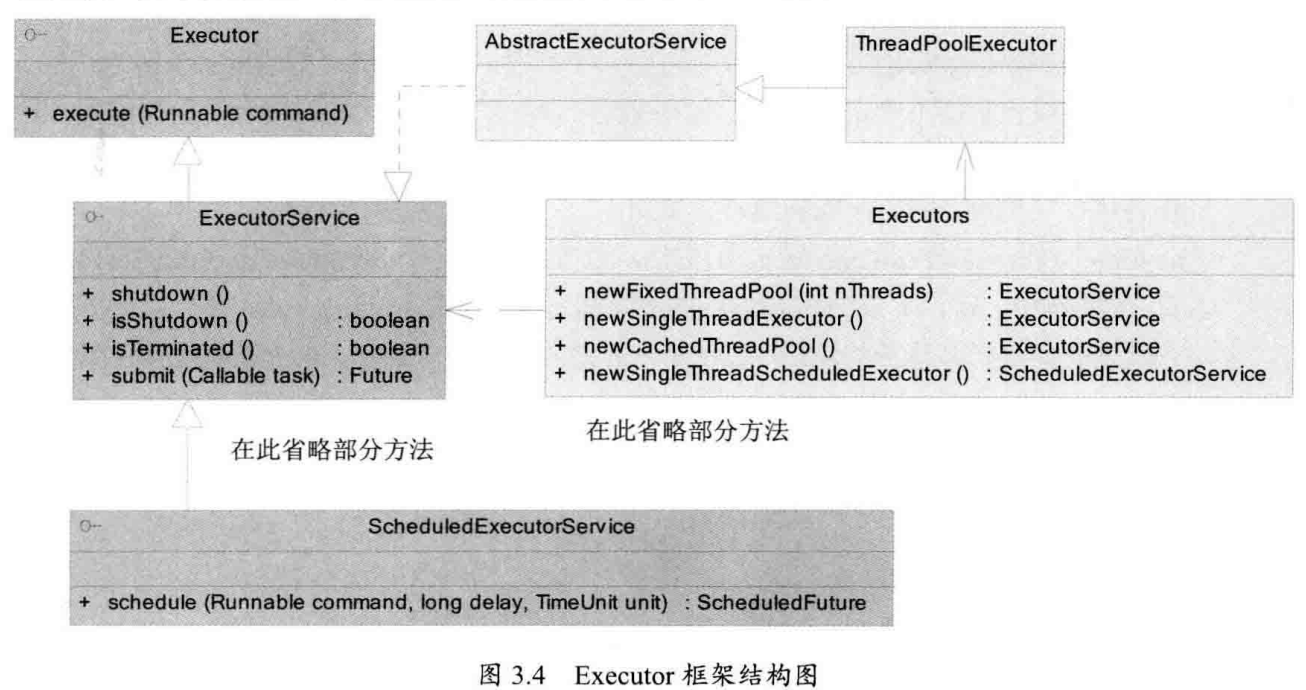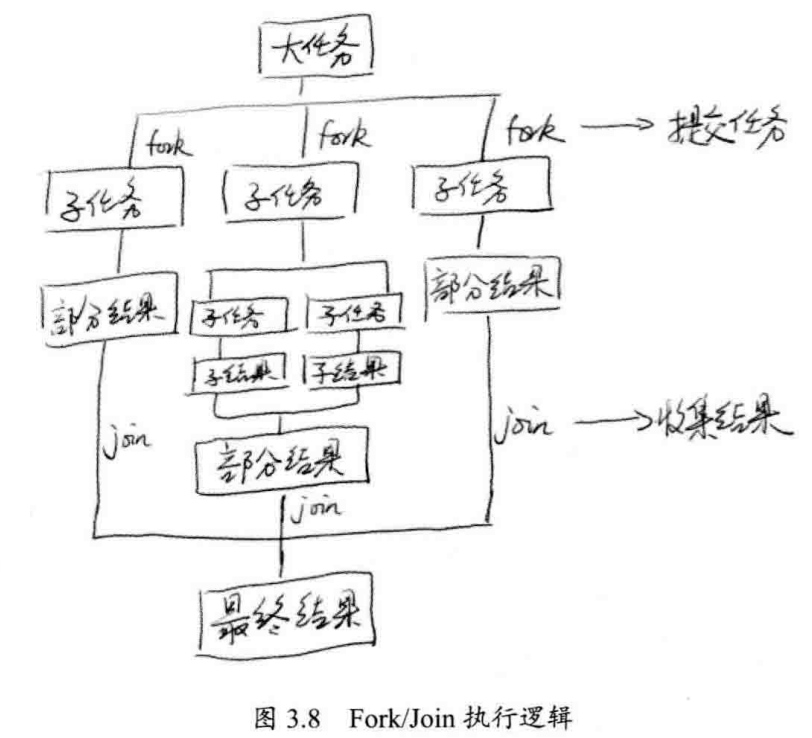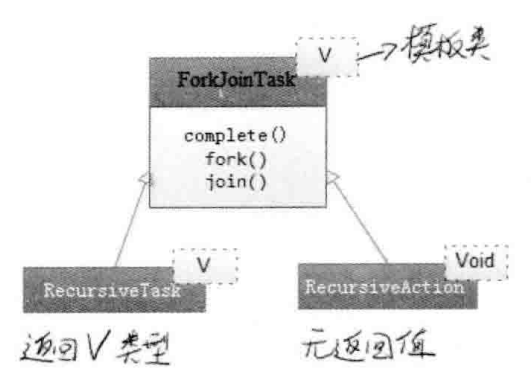线程复用:线程池
一、为什么需要线程池
为了避免系统频繁地创建和销毁线程,使用线程池让线程进行复用。(即创建线程变成了从线程池中获取空闲线程,销毁线程变成了把线程放回线程池中。)
二、JDK对线程池的支持:Executor框架
一)Excutor框架简介

public static ExecutorService newFixedThreadPool(int Threads) //返回一个固定线程数量的线程池,当新任务提交时无空闲线程,则任务进入等待队列,等待空闲线程。 public static ExecutorService newSingleThreadExecutor() //返回一个只有一个线程的线程池,多余的任务被提交到线程池,会进入等待队列,按先入先出顺序执行。 public static ExecutorService newCahedThreadPool() //返回一个可根据实际情况调整线程数量的线程池 public static ScheduledExecutorService newSingleThreadScheduledExecutor() //线程池中的线程可根据时间执行任务。 public static ScheduledExecutorService newScheduledThreadPool()
public class SESDemo { public static void main(String[] args){ ScheduledExecutorService p = Executors.newScheduledThreadPool(10); p.scheduleAtFixedRate(new Runnable() { @Override public void run() { try{ Thread.sleep(1000); System.out.println(System.currentTimeMillis()/1000+" and name is "+ Thread.currentThread().getName()); }catch (Exception e){ e.printStackTrace(); } } },0,2, TimeUnit.SECONDS); } } /*1504236959 and name is pool-1-thread-1 1504236961 and name is pool-1-thread-1 1504236963 and name is pool-1-thread-2 1504236965 and name is pool-1-thread-1 1504236967 and name is pool-1-thread-3 1504236969 and name is pool-1-thread-2 ....... 1504237017 and name is pool-1-thread-7 1504237019 and name is pool-1-thread-7 1504237021 and name is pool-1-thread-7 1504237023 and name is pool-1-thread-7 1504237025 and name is pool-1-thread-7 */
注意:任务本身不能抛出异常,不然后续所有执行都会被中断。
二)框架内部实现:
以上方法具体实现都使用了ThreadPoolExecutor,它们都封装了ThreadPoolExecutor

其中workQueue指被提交但未被执行的任务队列。

拒绝策略:线程池中的线程已经用完,队列也已经排满。
JDK内置的四种拒绝策略:
AbortPolicy:直接抛出异常,阻止系统正常执行。
CallerRunsPolicy:直接在任务提交的线程内执行线程。
DiscardOledestPolicy:丢弃最老的一个任务,并再次提交当前任务。
DiscardPolicy:丢弃无法处理的当前任务,不做其他处理。
以上策略都实现了RejectedExecutionHandler接口,如果以上策略无法满足我们的需求,我们可以扩展该接口。
public class RejectThreadPoolDemo { public static class MyTask implements Runnable{ @Override public void run() { System.out.println(System.currentTimeMillis()+" :Thread ID:"+ Thread.currentThread().getId()); try{ Thread.sleep(100); }catch (Exception e){ e.printStackTrace(); } } } public static void main(String[] args) throws InterruptedException { MyTask myTask=new MyTask(); ThreadPoolExecutor es = new ThreadPoolExecutor(5, 5, 0L, TimeUnit.MILLISECONDS, new LinkedBlockingDeque<>(10) , Executors.defaultThreadFactory(), new RejectedExecutionHandler() { @Override public void rejectedExecution(Runnable r, ThreadPoolExecutor executor) { System.out.println(r.toString() + "is discard"); } }); for (int i=0;i<Integer.MAX_VALUE;i++){ es.submit(myTask); Thread.sleep(10); } } }
三)自定义线程创建
线程池中线程的来源:ThreadFactory接口。override该接口中的
public Thread newThread(Runnable r);
方法即可。
四)扩展线程池
ThreadPoolExecutor是个可以扩展的线程池接口,它提供了beforeExecutor(),afterExecutor()和terminated三个接口对线程池进行控制。
public class ExtThreadPool { public static class Mytask implements Runnable{ private String name; public Mytask(String name) { this.name = name; } @Override public void run() { System.out.println("正在执行:线程ID"+Thread.currentThread().getId()+ "任务名:"+name); } } public static void main(String[] args) throws InterruptedException { ExecutorService es=new ThreadPoolExecutor(5,5,0L, TimeUnit.MILLISECONDS, new LinkedBlockingQueue<Runnable>()){ @Override protected void beforeExecute(Thread t, Runnable r) { System.out.println("准备执行:"+((Mytask)r).name); } @Override protected void afterExecute(Runnable r, Throwable t) { System.out.println("执行完毕:"+((Mytask)r).name); } @Override protected void terminated() { System.out.println("线程池退出"); } }; for (int i=0;i<5;i++){ Mytask mytask=new Mytask("task"+i); es.execute(mytask); Thread.sleep(10); } es.shutdown(); //所有任务执行完毕后,关闭线程池。 } }
五)线程池中寻找异常堆栈
解决多线程中幽灵般的异常:
方法一:放弃submit()改用execute()
方法二:extends ThreadPoolExecutor
六)分而治之,Fork/Join框架
分阶段对大量数据进行处理,然后对结果进行整合。

互助精神:

重要接口:
public <T> ForkJoinTask<T> submit(ForkJoinTask<T> task)
ForkJoinTask两个重要子类:
